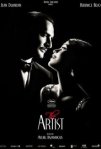The Artist: A Fun, Unique and Well Developed Cinematic Experience that Revives an Old One
 Director Michel Hazanavicius has put together a splendid, unique and interesting film in The Artist that gives most “cinemaphiles” the opportunity to experience the Silent Film with some modern twists. The result is an often fascinating and entertaining experience.
Director Michel Hazanavicius has put together a splendid, unique and interesting film in The Artist that gives most “cinemaphiles” the opportunity to experience the Silent Film with some modern twists. The result is an often fascinating and entertaining experience.
Premise: Taking place in Hollywood in 1927, a silent movie star, George Valentin, struggles with the arrival of talking pictures, just as he finds Peppy Miller, giving the young dancer a big break. Result: A beautiful, insightful film that manages to make an old art form feel new again.
The premise of this film is somewhat cliché. Essentially, George Valentin (Jean Dujardin) plays a very high profile silent film star who faces obscurity and financial ruin during the advent of “talkies”, films with actual soundtrack. His refusal to participate is prideful, as he considers himself “An Artist” and Talkies as a debasement of his art. In parallel, a young actress, Peppy Miller (Bérénice Bejo), who Valentin helped launch her career, is now exploding in fame as she rides the wave of the talkies to great heights.
Valentin’s career plummets into oblivion, his marriage to Doris (Penelope Ann Miller) unravels, and ultimately he finds himself living in a small apartment and selling all his earthly possessions at auction. Miller, despite their difference of opinion over talkies, attempts to show her love for him and hopefully save him from his downward spiral. And so on.
The premise here, ultimately, is quite cliché. But in this particular film, it all works for various reasons. First, the film is mainly about the experience of watching a silent film, an ironically new and intriguing experience for today’s filmgoers. To this point, it is important to keep complexity to a minimum since this is a new (or very old?) channel and thus allow observers to enjoy the full experience. Additionally, it is also helps to reflect the simpler nature of films in this genre while also pointing out how multi-faceted they could be (think brilliant silent films like The Cabinet of Dr. Caligari (1919) and Hands of Orlac (1924), amongst several others.)
The acting in this film is particularly fun for much the same reasons as the film itself is memorable: it teaches observers that there really was a distinct art form ins ilent films to those in which talking is heard. Here, characters needed to exaggerate certain emotions which did not translate (literally) to the talkies. In this vain, Dujardin and Bejo, who are both contemporary film makers, are quite impressive. Both dominate the picture (and recently some award nominations – SAG, Golden Globes) with their powerful performances in a genre not their own.
Miller and John Goodman as studio exec Al Zimmer, as well as the sad but effective James Cromwell as Clifton the chauffeur, are strong supporting roles. Each uses expressions to the utmost making their performances memorable.
Overall, The Artist is a fantastic experience for those who miss silent films and for those that love them. This film is fluid, beautiful and poignant. However, it may be most importantly a memorable experience for those unfamiliar with the genre or who willingly disregard it and its importance. This film teaches us about history in filmmaking the way boring, overhyped films like Hugo, fail to. Here, we are granted a window into a time and practice that otherwise exist as time capsules that appeal to our sense of history; The Artist, takes those memories and makes them fresh and entertaining for everyone, a feat that deserves the label of art in its highest form.
Rating: 8 – An expensive red wine and juicy steak

Leave a comment